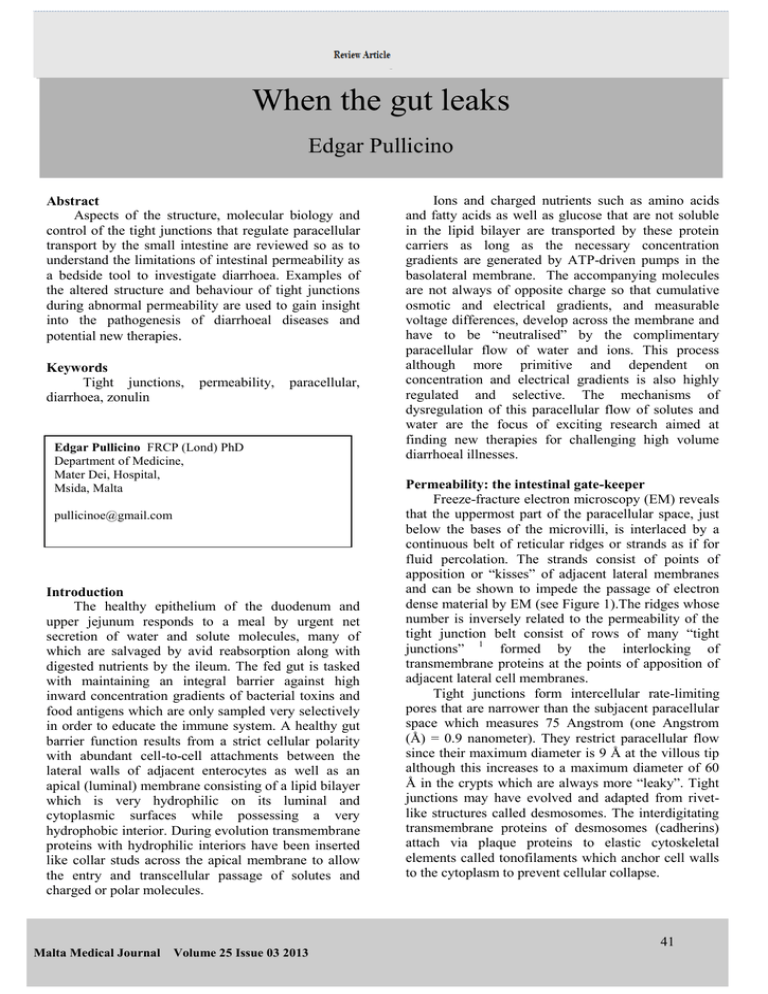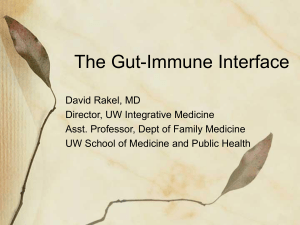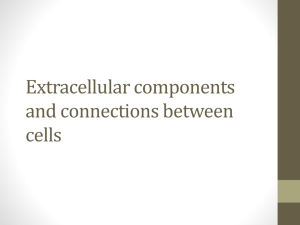Abstract Ions and charged nutrients such ... Aspects of the structure, molecular ...
advertisement

Original Article When the gut leaks Edgar Pullicino Abstract Aspects of the structure, molecular biology and control of the tight junctions that regulate paracellular transport by the small intestine are reviewed so as to understand the limitations of intestinal permeability as a bedside tool to investigate diarrhoea. Examples of the altered structure and behaviour of tight junctions during abnormal permeability are used to gain insight into the pathogenesis of diarrhoeal diseases and potential new therapies. Keywords Tight junctions, diarrhoea, zonulin permeability, paracellular, Edgar Pullicino FRCP (Lond) PhD Department of Medicine, Mater Dei, Hospital, Msida, Malta pullicinoe@gmail.com Introduction The healthy epithelium of the duodenum and upper jejunum responds to a meal by urgent net secretion of water and solute molecules, many of which are salvaged by avid reabsorption along with digested nutrients by the ileum. The fed gut is tasked with maintaining an integral barrier against high inward concentration gradients of bacterial toxins and food antigens which are only sampled very selectively in order to educate the immune system. A healthy gut barrier function results from a strict cellular polarity with abundant cell-to-cell attachments between the lateral walls of adjacent enterocytes as well as an apical (luminal) membrane consisting of a lipid bilayer which is very hydrophilic on its luminal and cytoplasmic surfaces while possessing a very hydrophobic interior. During evolution transmembrane proteins with hydrophilic interiors have been inserted like collar studs across the apical membrane to allow the entry and transcellular passage of solutes and charged or polar molecules. Malta Medical Journal Volume 25 Issue 03 2013 Ions and charged nutrients such as amino acids and fatty acids as well as glucose that are not soluble in the lipid bilayer are transported by these protein carriers as long as the necessary concentration gradients are generated by ATP-driven pumps in the basolateral membrane. The accompanying molecules are not always of opposite charge so that cumulative osmotic and electrical gradients, and measurable voltage differences, develop across the membrane and have to be “neutralised” by the complimentary paracellular flow of water and ions. This process although more primitive and dependent on concentration and electrical gradients is also highly regulated and selective. The mechanisms of dysregulation of this paracellular flow of solutes and water are the focus of exciting research aimed at finding new therapies for challenging high volume diarrhoeal illnesses. Permeability: the intestinal gate-keeper Freeze-fracture electron microscopy (EM) reveals that the uppermost part of the paracellular space, just below the bases of the microvilli, is interlaced by a continuous belt of reticular ridges or strands as if for fluid percolation. The strands consist of points of apposition or “kisses” of adjacent lateral membranes and can be shown to impede the passage of electron dense material by EM (see Figure 1).The ridges whose number is inversely related to the permeability of the tight junction belt consist of rows of many “tight junctions” 1 formed by the interlocking of transmembrane proteins at the points of apposition of adjacent lateral cell membranes. Tight junctions form intercellular rate-limiting pores that are narrower than the subjacent paracellular space which measures 75 Angstrom (one Angstrom (Å) = 0.9 nanometer). They restrict paracellular flow since their maximum diameter is 9 Å at the villous tip although this increases to a maximum diameter of 60 Å in the crypts which are always more “leaky”. Tight junctions may have evolved and adapted from rivetlike structures called desmosomes. The interdigitating transmembrane proteins of desmosomes (cadherins) attach via plaque proteins to elastic cytoskeletal elements called tonofilaments which anchor cell walls to the cytoplasm to prevent cellular collapse. 41 Original Article Figure 1: Freeze fracture electronmicrograph of zonula occludens below microvilli (MV) showing reticular pattern of strands (S) made up of many tight junctions reproduced with permission from Rockefeller University Press, originally published in Journal of Cell Biology 109: 179 – 189. Desmosomes may have assumed a tubular morphology while evolving into “gap junctions” These 30 Å channels are surrounded by hydrophilic connexon proteins that allow intercellular piping of molecules. They enable excitation spread in neural and cardiac tissue. Unlike gap junction, tight junctions can be opened and closed by contractile elements within the cytoskeleton that respond to intracellular signals generated by events such as alteration in cell hydration or transcellular transport. Inflammation may release cytokines which alter signal transduction and disrupt the crosstalk between the paracellular and transcellular routes thus causing diarrhoea. Open sesame! The molecular structure of two key tight junction proteins (occludins, claudins) was unravelled by Shoichiro Tsukitas and Mikio Furuse at Kyoto University. 2-3 Occludins span the apical region of the enterocyte lateral membrane four times (figure 2). Most of their charge is located in the cytoplasmic domain, which contains both the amino and carboxyl ends, leaving the two extracellular loops uncharged and therefore very hydrophobic. Homotypic binding Malta Medical Journal Volume 25 Issue 03 2013 (binding of identical proteins) of the two occludin loops is thought to help seal the pore. Exactly how occludin achieves a pore-size limit for solutes (approximately 600 Daltons) is not yet understood. In contrast, in claudins, the other family of tight junction proteins, the extracellular loops are highly charged and confer cation-specificity to various ions. Twenty-four isoforms of claudins have so far been discovered in the gut and elsewhere. Claudin-2 is abundant in the gut and is selective for sodium ions. Some claudins are pore-forming and increase intestinal permeability while others appear to close the junction. By having different proportions of the various claudins in different parts of the gut, chargeselectivity and size-selectivity patterns vary regionally in the small intestine. Elsewhere mutations in claudin16 cause abnormal renal tubular transport of two major cations resulting in Familial Hypomagnesaemic Hypercalcaemic Nephrocalcinois) (FHHNC) 4 Signaling (to open and close the pore) may result from homotypic binding of occludin to extracellular ligands (e.g. toxins, antigens, nutrients) or arise from binding of intracellular messengers (inside-out signaling) such as those released by pro-inflammatory cytokines. The carboxyl terminus of claudins also binds to scaffolding proteins which group and tether signaling components to the membrane, insulating them from other signal proteins and thus increasing signal transduction. It’s all about muscle! A ring of bipolar actin filaments containing myosin II surrounds the apical junction complex. 5 The carboxyl terminal of occludin attaches to a cytoplasmic plaque protein called ZO1 (zonula occludens protein 1) which links the tight junction to the actin-myosin complex making it possible for actinmyosin sliding to transmit forces to the tight junction (figure2). ZO1 together with the other cytoplasmic plaque proteins namely Z02 and 130KD protein belong to the family of kinases known as MAGUKs (membrane-associated gauniline-kinase. homologues). This suggests that they recruit proteins which anchor the actin filaments to the plasma membrane. 5 Isoforms of ZO1 probably determine the mechanical plasticity of the tight junction.6 Intracellular messengers such as the calcium–calmodulin complex increase ATP-ase activity in the myosin-actin complex and cause classic actin-myosin contraction. The centrifugal force is then transmitted through the plaque proteins so as to open the pore. Other intracelllular messengers such as cyclic AMP probably bring about shortening by altering the polymerisation of the actin chain. 42 Original Article entry of water pulled by the hyperosmolality in the tips of the villi that results from their rich blood supply and countercurrent exchange.10 Ischemia or loss of villi as in coeliac disease therefore results in reduced urinary recovery of administered mannitol. Figure 2: Interdigitation of TJ proteins (occludin and claudin) and their attachment to the sliding actinmyosin complex via plaque proteins (e.g ZO1, ZO2/3). Reproduced from Yu D, Turner JR. Stimulus-induced reorganization of tight junction structure: The role of membrane traffic. Biochimica et Biophysica Acta (BBA) 2008; 1778(3)709–716 with permission from Elsevier Permeability at the bed-side? Methods for in-vitro measurement of intestinal permeability have prompted methods for in-vivo measurements in the office or at the bedside. In the laboratory, the rate of passage of ions such as sodium across small intestinal epithelial preparations in-vitro can be estimated from the potential difference arising across cultured epithelial monolayers exposed to a known sodium concentration on the “luminal” side using the classic Ussing chamber.7 Two probes commonly used to study paracellular transport in vitro are lactulose and mannitol. Mannitol is a polyhdric alcohol with a molecular size of 3.9 Å while lactulose is a disaccharide with a molecular size of 5.1 Å8 Both are absorbed paracellularly to a similar extent in-vitro across villous tight junctions which have a maximum radius of 9 Å, typically with a lactulose : mannitol flux ratio of 0.78.9 At the bed-side small intestinal permeability is estimated from the ratios of the concentrations of lactulose and mannitol recovered in urine collected for 6 hours after oral dosing of these two probes. The use of two simultaneous oral probes helps to standardize estimates of permeability by compensating for inter-individual variations in intestinal surface-area and transit-time. Typical recoveries are 21.5% for mannitol and only 0.47% for lactulose i.e. a lactulose: mannitol recovery ratio (L:M) of 0.022. In clinical practice L:M ratios above 0.03 are indicative of a pathological increase in small intestinal permeability. The higher mannitol recovery in-vivo was initially thought to be due to transcellular transport 10 but the discrepancy is more likely to be explained by selective solvent drag of mannitol by rapid paracellular Malta Medical Journal Volume 25 Issue 03 2013 Permeability, a marker of disease to come? Permeability testing has the potential to detect early aberrations in intestinal physiology. For example prematurity in neonates is associated with high L:M ratios which fall rapidly as the epithelium responds to the trophic effects of feeding. L:M ratios are independent of growth in mucosal surface area, which would increase the absorption of both probes.11 Conversely progressive malnutrition is associated with proportional increases in permeability, even in the absence of villous atrophy.12 Other studies have shown that malnutrition augments bacterial translocation, increases antigen presentation to lamina propria T cells and raises circulating CRP and IL-6. Nathavitharana et al 13 reported significantly higher L:M ratios in children suffering from severe villous atrophy but permeability testing could not discriminate between patients with milder villous atrophy and healthy controls. The same authors found that high L:M ratios almost completely normalized within twelve weeks of gluten-withdrawal while subsequent gluten challenge was associated with a rapid increase in intestinal permeability. Bedside permeability testing is therefore not sensitive enough to screen for coeliac disease in the general population but may help to determine the optimal timing of duodenal biopsy during gluten challenge. Elevated L:M ratios which are reported with widely varying prevalence in first-degree relatives of coeliac patients increase the likelihood of celiac disease. Elevated circulating proinflammatory cytokines have been reported, and implicated in pathogenesis, in many but not all studies in patients with diarrhoeapredominant irritable bowel syndrome (D-IBS).14 Dunlop et al 15 found elevated intestinal permeability in both ordinary and post-infectious D-IBS (but not in constipated IBS patients) compared to healthy controls. The same authors found activation of mast cells, enterochromaffin cells and T-cells in rectal biopsies of other D-IBS patients. Jejunal mast cells are thought to be the main target of corticotrophin releasing factor during stress and their products, histamine and prostaglandins, are implicated in the increased jejunal permeability of D-IBS. The proximity of mast cells to the enteric nerves has also been implicated in the abdominal pain of IBS. Mast cells have not been found to be increased in postinfectious D-IBS patients who also show a lesser increase in intestinal permeability, presumably by a mast cell-independent mechanism.15 Bertiaux-Vandaële et al 16 found striking 43 Original Article differences in the expression of colon biopsy tight junction proteins (occludin, claudin, and zonula occludens 1 protein (ZO1) by PCR in 50 IBS (Rome 3 criteria ) patients of different subtypes compared to thirty healthy controls. The most striking differences were between D-IBS and controls. These differences were more marked for occludin than for claudin. The usual apical clustering of the tight junction proteins was lost in D-IBS patients. Recent onset of D-IBS was associated with higher occludin depletion suggesting that it was an early event in the pathogenesis of IBS, possibly due to occludin destruction by luminal proteases or by intracellular proteasomes activated by pro-inflammatory cytokines. Many asymptomatic relatives of Crohn’s disease patients demonstrate increased small intestinal permeability without evidence of immune activation suggesting that barrier dysfunction precedes the inflammatory process rather than being a consequence of it. A second hit (e.g. luminal pathogenic bacteria) is probably required to initiate the vicious spiral (whereby inflammation increases permeability and vice-versa) which is probably sustained by an increased entry of antigen into the submucosa. In a study of colon biopsies using freeze- fracture electronmicroscopically, immunocytochemistry and in-vitro permeability studies using the Ussing Chamber, Crohn’s disease patients with increased mucosal permeability exhibited reduced density of the strands formed by the tight junctions. The strands also show an increased number of breaks which correlated with disease severity. Strand disruption was just as prominent in non-ulcerated, non-apototic mucosa. It is now known that claudins are responsible for stranding. Expression of claudins-3, 5, and 8 which are poresealing were found to be decreased while pore-opening Claudin 2 was found to be increased particularly in the crypts. Since these changes were only seen in active Crohn’s disease and were proportional to disease activity they were presumed to be a consequence of, rather than a prelude to, disease activity.17 Three Crohn’s disease-related cytokines IL-13, TNF-alpha and IFN-gamma increase intestinal permeability in vitro.18 However only IL-13 increases intestinal Claudin-2 expression. 19 Mice treated with TNF-alpha developed increased intestinal permeability within 3 hours of T-cell activation. 18, 20 There was no rise in claudins but there was an increased phosphorylation of Myosin II light chain kinase suggesting that TNF can lead to pore-opening by inducing myosin-actin sliding rather than by claudin expression. The presence of more than one pathway to permeability, each mediated by different cytokines, increases potential therapeutic strategies but may explain why TNF-directed therapy may not be enough to induce remission Malta Medical Journal Volume 25 Issue 03 2013 Cholera-related research recently discovered that the normal intestine also produces luminal agents which control permeability. Besides the classic 84kD toxin which catastrophically opens enterocyte apical chloride channels, Vibrio cholerae produces a second “Zonula Occludens” Toxin (ZOT) which binds to surface receptors present on enterocytes (but not on colonocytes) to cause protein kinase C-dependent polymerisation of actin filaments that open the tight junctions (Figure 2). The paucity of ZOT receptors in the crypts, which are leaky anyway as compared to the villi, led to the search for an endogenous ZOT-like substance that the enterocyte may release to regulate villous permeability. A 47 kD analogue of ZOT called Zonulin is in fact produced by the intestine as part of host defence after exposure to bacteria even if these are commensals or killed by gentamycin 21 allowing the small intestine (but not the colon) to flush itself of bacterial overgrowth. Heightened zonulin secretion characterises the early phase of coeliac disease and may predispose to type 1 diabetes mellitus and other autoimmune diseases by increasing entry of luminal antigens. Quantitative immunoblots from intestinal tissue in coeliac disease patients showed significantly higher zonulin than in controls. 22 An octapeptide zonulinreceptor inhibitor joins propyl dipeptidases and transglutaminase inhibitors in the list of candidate future oral agents that aim to restore wheat tolerance in coeliac patients. Conclusion The paracellular route of transport of fluids and solutes in between the enterocytes of the human small intestine, regulated by tight junctions, holds the key to unraveling the mechanisms underlying the clinical problem of high-volume diarrhoea that spans many inflammatory, allergic and autoimmune diseases. An understanding of the altered physiology in these scenarios will likely result in the testing of many exciting new therapeutic strategies. References 1. 2. 3. 4. Farquhar M, Palade GE. Junctional complexes in various epithelia. J. Cell. Biol. 1963; 17: 375-412 Furuse M, Hirase T, Itoh M, Nagafuchi A, Yonemura S, Tsukita Sa, Tsukita Sh. Occludin: a novel integral membrane protein localizing at tight junctions. J Cell Biol. 1993; 123:1777–1788. Furuse M, Fujita K, Hiiragi T, Fujimoto K, Tsukita Sh. Claudin-1 and -2: novel integral membrane proteins localizing at tight junctions with no sequence similarity to occludin. J. Cell Biol. 1998; 141:1539–1550. Simon DB, Lu Y, Choate KA, Velazquez H, Al-Sabban E, Praga M, et al .Paracellin-1, a renal tight junction protein required for paracellular Mg2+ resorption. Science. 1999; 285:103–106. 44 Original Article 5. 6. 7. 8. 9. 10. 11. 12. 13. 14. 15. 16. 17. 18. 19. 20. 21. 22. Anderson JM, Van Itallie CM. Tight junctions and the molecular basis for tight junction permeability. Am. J. Physiol. (Gastrointest. Liver. Physiol. 32). 1995; 269: G467 – G475. Menard S, Cerf-Bensussan N, Heyman M. Multiple facets of intestinal permeability and epithelial antigen handling of dietary antigens. Mucosal Immunology. 2010; 3(3) : 247256. Ussing HH, Zerahn R. Active transport of sodium as the source of electric current in the short-circuited isolated frog skin. Acta Physiol. Scand. 1951; 23; 110–127. Ghandehari H, Smith PL, Ellens H, Yeh P, Kopeček J. Sizedependent permeability of hydrophilic probes across rabbit colonic epithelium. J Pharmacol Exp Therapeutics. 1997; 280: 747-753. Bijlsma PS, Peters RA, Groot JA, Dekker RA, Taminiau JA, Van der Meer R. Differential in- vivo intestinal permeability to lactulose and mannitol in animals and humans: a hypothesis. Gastroenterology 1995; 108: 687-696. Menzies IS. Transcellular passage of inert molecules in health and disease. in: Skadhuage E, Heinze K, eds Intestinal absorbtion and secretion. Falk symposium 36. Lancaster England: MTP,1984:527 – 543. Weaver L, Laker MF, Nelson R. Intestinal permeability in the newborn. Arch Dis Childhood. 1984; 59: 236-241. Welsh FK, Farmery M, MacLennan K, Sheridan MB, Barclay GR, Guillou PJ, Reynolds JV. Gut barrier function in malnourished patients. Gut. 1998; 42: 396-401. Nathavitharana KA, Lloyd DR, Raafat F, Brown GA, McNiesh AS. Urinary mannitol:lactulose excretion ratios and jejunal mucosal structure. Arch Dis Childhood. 1988; 63: 1054-1059. Chang L, Adeyemo M, Karagiannidis I, Videlock EJ, Bowe C, Shih W, Presson AP, Yuan P , Cortina G, Gong H et al. Serum and colonic mucosal immune markers in irritable bowel syndrome. Am J Gastroenterol. 2012; 107:262–272. Dunlop SP, Hebden J, Campbell E, Naesdal J, Olbe L, Perkins AC, et al. Abnormal intestinal permeability in subgroups of diarrhea-predominant irritable bowel syndromes. Am J Gastroenterol. 2006; 101(6):1288-94. Bertiaux-Vandaële N, Youmba SB, Belmonte L, Lecleire S, Antonietti M, Gourcerol G, Leroi et al. The expression and the cellular distribution of the tight junction proteins are altered in irritable bowel syndrome patients with differences according to the disease subtype. Am J Gastroenterol. 2011; 106(12):2165-73. Zeisig S, Burgel N, Gunzel D, Richter J, Mankertz J, Wahnscaffe U et al. Changes in expression and distribution of Claudin 2, 5 and 8 lead to discontinuous tight junctions and barrier dysfunction in active Crohn’s disease. Gut 2007; 56: 61-72. Weber CR, Turner JR. Inflammatory bowel disease: is it really just another break in the wall? Gut 2007; 56(1): 6-8. Prasad S, Mingrino R, Kaukinen K. Inflammatory processes have different effects on claudins 2, 3 and 4 in colonic epithelial cells. Lab Invest. 2005; 85: 1139-62. Clayburgh R, Musch MW, Leitges M, Fu YX, Turner JR. Coordinated epithelial NHE3 inhibition and barrier dysfunction are required for TNF-mediated diarrhea in vivo. J Clin Invest 2006; 116: 2682-94. Fasano A. Intestinal zonulin: open sesame. Gut 2001; 49: 159-162. Visser J, Rozing J, Sapone A, Lammers K, Fasano A. Tight junctions, intestinal permeability, and autoimmunity, Celiac Disease and Type 1 Diabetes Paradigms. Ann N Y Acad Sci. 2009; 1165: 195–205. Malta Medical Journal Volume 25 Issue 03 2013 45



